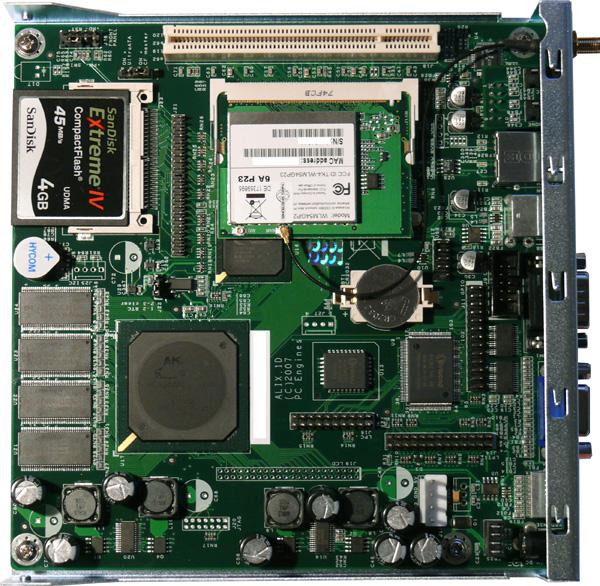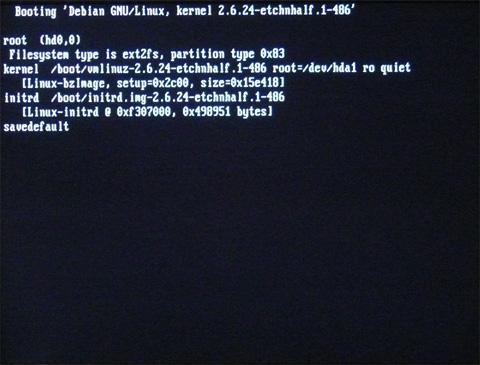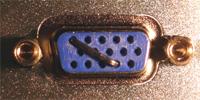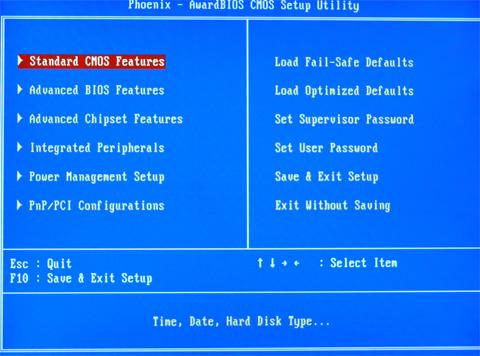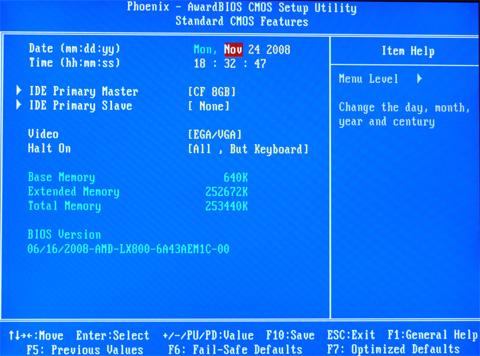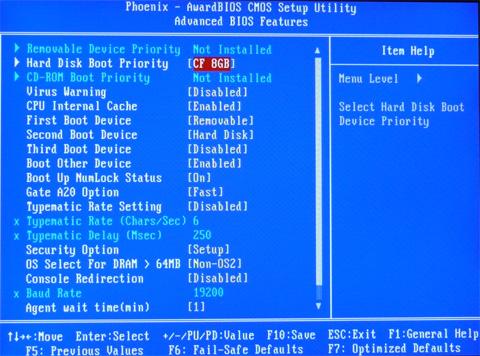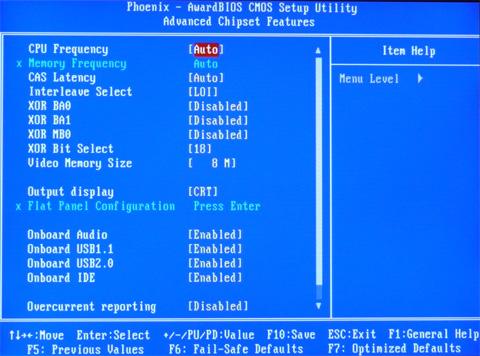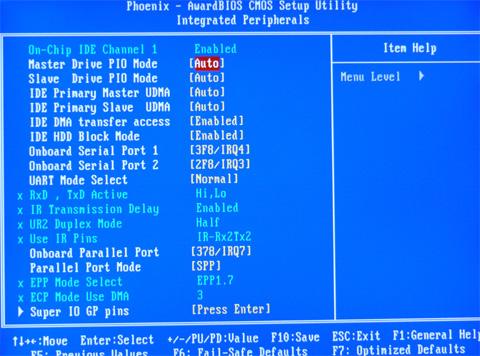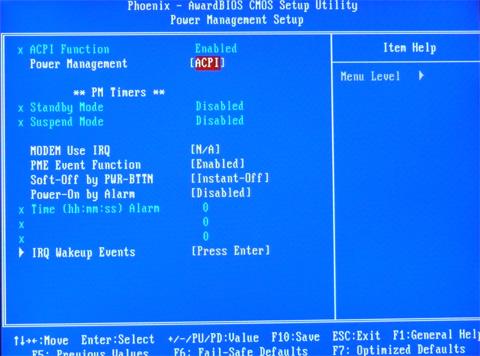Setup ALIX.1D
HW Setup
You need the following items to setup Meteohub hardware based on ALIX.1D board:
- PC Engines ALIX.1D system board
- PC Engines indoor metal case (black) for ALIX.1D / ALIX.1C (incl. screws and rubber feet)
- suitable external power supply (rated 12V 1.2 A)
- 4GB CF card
- optional: Compex WLM54G WLAN miniPCI card (802.11 b/g support)
- optional: WLAN antenna with 15 cm connector cable to miniPCI WLAN card
Having these items, installation of hardware components can be done in a few minutes. All you need is a screw driver.
- Unscrew the 4 screws that are at the back of system board's VGA and RS2321. Unscrew the 4 screws that are at the back of system board's VGA and RS232 connectors. These have to be removed temporarily to get the upper part of the case mounted in step 6.
- Mount system board on the lower part of the case and fix it with 4 small silver screws.
- Put CF card into corresponding on-board slot (see picture).
- optional: Put minPCI WLAN adapter into corresponding miniPCI slot. MiniPCI cards are mounted in three steps:
- lift non-connecting side a bit
- push connector side into the slot while also pressing down the non-connecting side
- when you hear "click" it is fixed (see picture for final state).
- optional: Mount WLAN connector into the corresponding hole of the case. Connect the end of the cable with "MAIN" labeled connector on WLAN adapter (see picture). The connector is tiny, make sure it is positioned correctly, then press to make it snap in.
- Screw the 4 screws from step 1 into VGA and RS232 connector again. The screws will support stability and allow to fix VGA and RS232 cables with dump screws that fit into the heads of the screws used here.#. Mount upper part of the case, screw this by 4 black screws, put 4 rubber feet below the case.
When booting ALIX.1D without having a monitor connected (or with having an old monitor connected that does not report monitor type on pin 12 correctly) boot procedure will halt at messages "savedefault" (see picture). To avoid this, pins 12 and 5 on VGA connector of ALIX.1D have to be connected. This can easily done by cutting and folding a 18 mm long piece from a paper clip and folding it into u-shape with 5 mm long legs on the ends and a 8 mm long part in-between. Don't forget to remove the bridge before trying to connect a monitor to ALIX.1D. After having done successful boot, the paper clip bridge can be plugged of or an old monitor that does not work for booting can be reconnected, if needed.
Setup of USB Stick
Meteohub installation makes use of a bootable USB stick (minimum capacity 512 MB) that transfers necessary data to CF card of your ALIX box. Download zipped USB stick image "meteohub-vxyz.zip" (or newer) from here and unzip the image with a tool of your choice. Result is "meteohub-vxyz.img". Next step is to bring the data to the USB stick.
Windows
On Windows you need to download and run a special tool to do the required low-level writing to the USB stick. The tool of choice is "ImageWriter" from SuSE (you find additional information about this tool here). Please download ImageWriter.exe to your Windows PC. It does not need to be installed it is just a small executable to run. Please insert the USB stick into your PC wait a few seconds and then start downloaded "ImageWriter.exe". Wait until a dialog like this pops up:
Please select the inserted USB stick from the target drop-down list. Then open the file browser by clicking "Select" button. "*.img" files are not displayed by default so first thing to do is to enter "*.*" as file name. Having done that you will see the file "meteohub-vxyz.img" on the list. Select and open this file. Dialog should now look like this:
Press "copy" and the image data will be written to USB stick. When operation has finished without error, you are done with this step. Please pull the USB stick from your Windows PC.
Linux
On Linux you use the "cat" command. Please insert the USB stick into your Linux box and check via "dmesg" what device the stick has been mapped to. In the following example it has been mapped to "/dev/sdj"
# dmesg ... [708634.148013] usb 2-8: new high speed USB device using ehci_hcd and address 9 [708634.566078] usb 2-8: New USB device found, idVendor=058f, idProduct=6387 [708634.566082] usb 2-8: New USB device strings: Mfr=1, Product=2, SerialNumber=3 [708634.566084] usb 2-8: Product: Mass Storage Device [708634.566086] usb 2-8: Manufacturer: JetFlash [708634.566088] usb 2-8: SerialNumber: Q05E7OLZ [708634.566409] scsi24 : usb-storage 2-8:1.0 [708635.613921] scsi 24:0:0:0: Direct-Access JetFlash TS4GJF130 8.07 PQ: 0 ANSI: 2 [708635.614072] sd 24:0:0:0: Attached scsi generic sg9 type 0 [708635.617302] sd 24:0:0:0: [sdj] 7987200 512-byte logical blocks: (4.08 GB/3.80 GiB) [708635.617910] sd 24:0:0:0: [sdj] Write Protect is off [708635.617913] sd 24:0:0:0: [sdj] Mode Sense: 03 00 00 00 [708635.617915] sd 24:0:0:0: [sdj] Assuming drive cache: write through [708635.621534] sd 24:0:0:0: [sdj] Assuming drive cache: write through [708635.621538] sdj: sdj1 [708635.624279] sd 24:0:0:0: [sdj] Assuming drive cache: write through [708635.624281] sd 24:0:0:0: [sdj] Attached SCSI removable disk
We are just looking for "sdj" and are not interested in the partitions recognized on the stick (sdj1). The print out above tells that "/dev/sdj" is the target device. To make sure that the device ist not mounted by some background processes you should manually unmount all partitions by "umount". In the given example this will be
umount /dev/sdj1
When this throws errors about not mounted file systems that is fine. Don't worry. Now it is time to bring the Meteohub image onto the stick. In the example above this will be done by
cat meteohub-vxyz.img >/dev/sdj
Please be careful with that command. When you choose the wrong target (i.e. your system drive) this will be overwritten without further notice and you will have to restore your Linux box! When "cat" has completed without error, this step is finished and you can pull the USB stick from your Linux box.
Installation from USB Stick
Connect monitor and USB keyboard to your ALIX.1D
- Boot into BIOS by pressing "Del" key during startup. Once in BIOS select "Advanced BIOS Features" tab and choose "Removable" as "First Boot Device". Select "Hard Disk" as "Second Boot Device". Press "F10" to store this configuration and restart.
- plugin USB stick to boot from
- System boots a Debian Linux from USB stick and starts Meteohub setup procedure for CF card. Data already stored on the media will be erased without further warning!
- Installation process halts with asking you to remove USB stick and to restart the system once again. Please press "Del" key during boot to enter BIOS setup mode.
- Select "Advanced BIOS Features" tab and choose "Hard Disk" as "First Boot Device". Press "F10" to store this configuration and to restart.
- Now Meteohub should start properly from CF card. Keyboard and Monitor can be disconnected. Please remember to put the paper clip at the VGA connector, when disconnecting the monitor!
Start Meteohub
- You can now reach the Meteohub system by your desktop's/laptop's browser at the emergency IP 192.168.1.77 ("http://192.168.1.77") and if you have a DHCP server in your LAN you also can find your Meteohub at the address given by the DHCP server. [b]User name is "meteohub", password is "meteohub"[/b]. To reach the emergency IP with your browser you probably have to do reconfigure the IP address of your desktop/laptop as described in #Setup of unmodified NSLU2 in your LAN (explains how to bring you desktop into the same subnet as Meteohub). Having reached the Meteohub web interface you can set the IP persistently.
- Furthermore, the Windows tool "ipscan" (download here might be helpful to examine the IP that the router has given Meteohub via DHCP, if Meteohub is configured to make use of a dynamic IP via DHCP.
- About a minute after reboot Meteohub signals its IP by specific beeps.
- Remark: If you have monitor and keyboard connected to Meteohub system, you can login (user "root", password "meteohub") and give command "setip" to manually give Meteohub an IP that fits to your LAN. This IP gets immediately valid without need of a reboot.
Read the Beeps
About one minute after starting reboot Meteohub signals its IP by the build in beeper. You can disable this noisy but sometimes helpful feature by placing a file named "noreadip" into the pc network folder "/public/log". Signaling of the IP starts with a low frequency tone of a long duration. After that each of the four numbers (delimited by a dot) will be signaled one by one. The dot between the numbers will be signaled by a high frequency tone. Each number is signaled by sending beeps digit per digit. Each digit is represented by a middle frequency tone repeated as often as the digit tells us. The zero digit is signaled by ten beeps. After having done this for all digits of all numbers of the IP, the end is signaled by a low frequency, long beep like it started with.
Example: IP 192.168.10.77 Legend: L = low freq. tone, M = middle freq. tone, H = high freq. tone, _ = pause
Signal: Comment LLLL___M___M_M_M_M_M_M_M_M_M___M_M___H 192 ___M___M_M_M_M_M_M___M_M_M_M_M_M_M_M___H 168 ___M___M_M_M_M_M_M_M_M_M_M___H 10 ___M_M_M_M_M_M_M___M_M_M_M_M_M_M___LLLLL 77
When Meteohub does not have a valid IP this will be signaled with three low frequency beeps shortly following each other.
BIOS Settings
In case your system does not start from CF card, please check that your BIOS settings are like displayed below.
